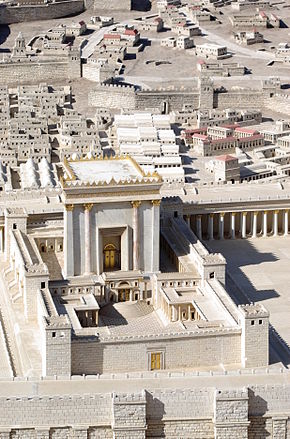Second Temple of Jerusalem
| בית־המקדש השני | |

Model of Herod's Temple (a renovation of the Second Temple) in the Israel Museum, created in 1966 as part of the Holyland Model of Jerusalem. The model was inspired by the writings of Josephus.
|
|
| Alternate name | Herod's Temple |
|---|---|
| Location | Jerusalem |
| Coordinates | 31°46′41″N 35°14′07″E / 31.778013°N 35.235367°E |
| Type | Temple |
| Part of | Herodian Temple Mount |
| Height | 45.72 metres (150.0 ft) |
| History | |
| Builder | Likely Zerubbabel, largely renovated by Herod the Great. |
| Material | local limestone |
| Founded | c. 537 - 516 BCE |
| Abandoned | 70 CE |
| Periods | Early Roman Empire |
| Site notes | |
| Excavation dates | 1930, 1967, 1968, 1970–1978, 1996–1999, 2007 |
| Archaeologists | Charles Warren, Benjamin Mazar, Ronny Reich, Eli Shukron, Yaakov Billig |
| Condition | Ruin, archaeological park |
| Ownership | Disputed, currently managed by the Jerusalem Islamic Waqf |
| Public access | Yes (limited) |
The Second Temple (Hebrew: בֵּית־הַמִּקְדָּשׁ הַשֵּׁנִי, Beit HaMikdash HaSheni) was the Jewish Holy Temple which stood on the Temple Mount in Jerusalem during the Second Temple period, between 516 BCE and 70 CE. According to Judeo-Christian tradition, it replaced Solomon's Temple (the First Temple), which was destroyed by the Babylonians in 586 BCE, when Jerusalem was conquered and part of the population of the Kingdom of Judah was taken into exile to Babylon.
Jewish eschatology includes a belief that the Second Temple will be replaced by a future Third Temple.
The accession of Cyrus the Great of the Persian Empire in 559 BCE made the re-establishment of the city of Jerusalem and the rebuilding of the Temple possible. According to the Bible, when the Jewish exiles returned to Jerusalem following a decree from Cyrus the Great (Ezra 1:1–4, 2 Chron 36:22–23), construction started at the original site of Solomon's Temple. After a relatively brief halt due to opposition from peoples who had filled the vacuum during the Jewish captivity (Ezra 4), work resumed ca. 521 BCE under Darius the Great (Ezra 5) and was completed during the sixth year of his reign (ca. 516 BCE), with the temple dedication taking place the following year.
...
Wikipedia
